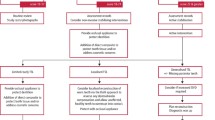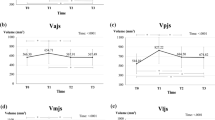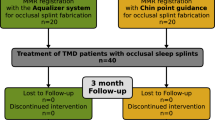Key Points
-
Reviews the mechanism and common causes of temporomandibular joint (TMJ) dislocation.
-
Discusses the techniques for reduction of TMJ dislocation, both ancient and modern.
-
Examines how a particular medical procedure first documented in antiquity is still in use today.
Abstract
The first known recorded evidence for the reduction of a mandibular joint dislocation is documented in a papyrus dated to c. 1500 BC that originated from ancient Egypt. This same technique was later discussed by Hippocrates in Greece and the Hippocratic corpus is referred to in early Islamic writings. It is detailed in medieval European texts and eventually was incorporated into modern dental and medical practice. Today, mandibular joint dislocation is probably not that common but to be included in an important ancient Egyptian treatise, predominately concerned with trauma to the head and neck, could suggest it was a more frequent occurrence in antiquity. This could relate to the heavy tooth wear, frequent antemortem tooth loss and the related sequelae of severe malocclusion and overclosure evident in many surviving ancient Egyptian skulls.
Similar content being viewed by others
Introduction
It is often difficult to determine when a treatment for a particular injury or ailment was first described in the historical record. Some of the earliest accounts of medical treatments relate to the physician Hippocrates and are documented in the Hippocratic corpus. Many of these ancient Greek medical works, numbering approximately 60 manuscripts in total, are considered to date from the end of the fifth century to the beginning of the fourth century BC.1,2
Historical background
However, the ancient Egyptians have handed down a series of ancient texts written on papyrus which permit a glimpse at medical procedures, healing practices and treatments relating to that early civilisation. These documents, known as the medical papyri were written approximately 1,000 years before the Hippocratic corpus. One of these is the Edwin Smith papyrus, named after its original owner, an American Egyptologist, who purchased it from a merchant in Luxor in 1862. The papyrus is now located in the New York Academy of Medicine and is considered to date to approximately 1550 BC (Fig. 1). The document is basically a treatise on trauma neatly written in hieratic, the cursive form of ancient Egypt's hieroglyphic script, and is fundamentally different from any other surviving medical papyrus unearthed from Egypt. These other medical papyri are mainly lists of recipes or prescriptions used in the treatment of various ailments and often incorporate a magical incantation within the text. In contrast the Edwin Smith papyrus is a systematically organised manuscript consisting primarily of surgical cases in which prognoses are provided and predominately rational therapies specified.
Within the papyrus is a procedure (case 25) for correcting a dislocation of the mandible which dates back some 3,500 years. The technique clearly demonstrates a logical approach to the condition and the straightforward treatment prescribed, which, although simple, differs little from that in use today in dental surgeries and hospital accident and emergency departments:
'If you should examine a man having a dislocation in his mandible, and should you find his mouth open, and his mouth cannot close for him. Then you must put your thumbs upon the ends of the two rear sections of the forked bones (rami) of the mandible, in the inside of his mouth and your two claws (meaning two groups of fingers) under his chin. Then you should cause them to fall back, so that they are put in their places.'3,4,5
Later, Hippocrates was to discuss the treatment for a dislocated mandible in his account On the articulations and his method bears strong similarities to the technique recorded in the Edwin Smith papyrus6,7 (Fig. 2). Hippocrates described the same basic principle of closed reduction as documented in the papyrus, while also expanding considerably on the description of the signs and treatment. This similarity could indicate a possible ancient Egyptian influence on Greek medicine. Certainly, following the Greek invasion of Egypt in 332 BC many Greek intellectuals were to visit and study in Egypt staying principally at Alexandria, the city they established.4 It was here in Alexandria in approx imately 280 BC that the various tracts of the Hippocratic corpus were first compiled.1,8 The pharmacopeia of Hippocratic medicine includes products from Egypt such as nitrate, oil and alum. Additionally, there are a number of references to the positive nature of Egyptian medicine in the writings of Greek authors such as Homer, Herodotus and Diodorus Siculus.9
It is also possible that the Hippocratic technique to reduce a dislocated mandible was not necessarily affiliated from the ancient Egyptian method, as such a therapeutic act may be one of those elementary practices established in many civilisations, even before medicine became a codified art.10 Nevertheless, the close resemblance between the two methods has resulted in a number of researchers identifying a connection.4,7,11
Later with the rise and expansion of imperial Rome, the Hippocratic corpus was to become a significant part of Roman medical practice. During the medieval period Islamic medical knowledge and practices were among the most advanced of the pre-modern world. This medical tradition was originally founded on Greco-Roman medicine but later Islamic culture came to develop its own scholarship. Many classical texts, including parts of the Hippocrates corpus, which might otherwise have been lost, were translated into Arabic.12 By AD 950 Arabs were settling in Europe and their Islamic heritage was passed on to other cultures. Many Arabic texts were translated into Latin by western scholars and it is known that a number of these researchers also consulted earlier Greek versions (Fig. 3).
Some of these earliest medical texts in Europe, dating to the eleventh century AD, came from the Salerno medical school in southern Italy.1 In the Middle Ages Greek medicine was to form the basis of the university medical curriculum and in 1525 in Venice new editions of the Hippocratic corpus were being published.13 Between the seventeenth and nineteenth centuries the influence of Hippocrates was still being felt in Western Europe. Thomas Sydenham (1624–1689), a physician, often considered the father of English medicine and an influential figure in eighteenth century England, extolled the value of Hippocratic clinical medicine. He integrated some of these theories into his own medical practices and revitalised Hippocrates' teachings. Finally, Hippocratic medicine which is based on an observation of clinical signs and rational conclusions, while not relying on religious or magical beliefs, found its way into modern medical theory. Included within the works was the Hippocratic method of correcting a dislocated mandible, a technique first committed to writing by the ancient Egyptians some 3,500 years previously.
Temporomandibular joint dislocation: Discussion
Temporomandibular joint (TMJ) dislocation occurs when the head of the mandibular condyle is displaced beyond its usual limits without a spontaneous return to the normal resting position. Whilst anterior, posterior, lateral and superior displacements can occur, anterior dislocation is by far the most common condition.14,15,16 Dislocation occurs when there is an interruption in the normal sequence of muscle action during closure from maximal opening, resulting in the condyle being displaced anteriorly beyond the articular eminence (Fig. 4). The masseter, pterygoid and temporalis muscles go into spasm attempting to close the mandible causing trismus, which results in the condyle being unable to return to the temporal fossa.15
Adapted from Lowery et al.15
Potential circumstances for TMJ dislocation include any action that involves the mouth being maximally open. Common causes include yawning, laughing, vomiting, attempting to chew a large food bolus, trauma and dental treatment.17 Early reduction of the dislocated joint is important in reducing permanent sequelae, such as discomfort, impaired function and facial deformity, and the aim is to bring the condylar head down and around the articular eminence of the TMJ. This action can be achieved by inferior and posterior pressure on the mandible.17,18
Today mandibular dislocation at the temporomandibular junction is an infrequent presentation at accident and emergency departments of hospitals.15,19 Lovely and Copeland19 described this condition as representing 3% of all reported dislocated joints in the body. However, dislocation in the dental surgery may be more frequent but go largely unrecorded as the attending clinician would normally reduce the dislocation at the time.
Temporomandibular joint dislocation in ancient Egypt
So why should such a comparatively rare condition as a dislocation of the mandible be included among the twenty-seven cases listed in the Edwin Smith papyrus relating to the head that involve significant injuries such as compound fractures, stab wounds and serious head lesions? The ancient treatments provided for these major injuries include the application of medicaments, suturing and bed rest. Of the treatments documented in the papyrus, case 25, the correction of a dislocated mandible, is notable in that such a striking injury is able to be treated quickly and in an effective manner. Lipton suggests that it may have been included so as to highlight the difference between the reversible locking open of a dislocation from the fatal locking shut or trismus, of tetanus.11
However, TMJ dislocation although a comparatively rare injury today may have been more commonplace in antiquity. In ancient Egypt, excessive tooth wear was widespread and is a condition that has been found in very many of the surviving ancient Egyptian skulls throughout the dynastic period20,21,22,23 (c. 3000–30 BC). The primary cause of this tooth wear was the chewing throughout life of a coarse fibrous diet made even more abrasive by the introduction of inorganic particles, such as quartz from sand which was blown in from the desert and fragments from soft sandstone implements that were used to grind the grain. This tooth wear varied from a slight polishing of the cusps to almost complete loss of crown structure. Often it was so extensive it occurred at a faster rate than the odontoblasts were able to lay down secondary dentine, resulting in pulpal exposure, necrosis of the pulp and subsequent apical infection.23 As a result many ancient Egyptian skulls display considerable numbers of teeth lost antemortem and with the associated tooth wear on the remaining teeth, severe malocclusion and overclosure would have resulted during life.
Such long-term overclosure from lack of posterior support and loss of vertical dimension would cause chronic stretching of the capsular and lateral ligaments of the TMJ and result in altered mechanical function.24,25 As a consequence, recurrent dislocation or chronic luxation may ensue and because of the widespread malocclusion and overclosure evident in the dentitions of the ancient Egyptians, TMJ dislocations may not have been that uncommon.
Modern treatments
As mentioned above, the conventional approach for reduction described in the Edwin Smith papyrus, and little changed since, involves using intraoral, bilateral and inferior-posterior downward force on the mandible. Whilst effective if performed soon after the traumatic injury, some operators, particularly those based in accident and emergency departments, who may be presented with a condition that has existed for some time, note that on occasions considerable force and sedation may be necessary to facilitate reduction.15,16,26 Occasionally, surgical intervention is required but is usually only necessary for chronic recurrent and persistent dislocations, whereas in acute forms nearly all cases are managed by manual reduction.27
More recently, alternative techniques have been described. Lowery et al.15 report a wrist pivot method based on the intrinsic biomechanical properties of the mandible, but only one case is considered. Chen et al.16 discuss an extraoral reduction technique utilising steady pressure on the cheek and coronoid process. However, a later evaluation of this technique by Ardehali et al.28 found that while reasonable success was achieved using this method, a significant number of patients still needed the intraoral approach. Cheng26 describes a unified hands technique involving intraoral unilateral application of both hands on the side of the dislocated mandible, but again only one case is presented.
Conclusion
In conclusion, the treatment for a dislocated mandible has a long history, first recorded in ancient Egypt some 3,500 years ago and evident in Europe in the Middle Ages. Today's practitioners, being the recipients of such knowledge, still use this procedure. Often called the Hippocratic method, this article has described how this technique was known in Egypt some 1,000 years before the Hippocratic corpus was first complied. More recently, alternative techniques have been described and, although useful in certain circumstances, the traditional method is still universally popular and has certainly stood the test of time.
References
Nutton V . Medicine in Medieval Western Europe. In Conrad L I, Neve M, Nutton V, Porter R, Wear A (eds) The western medical tradition 800 BC to AD 1800. pp 139–205. Cambridge: Cambridge University Press, 1995.
Jouanna J . Hippocrates, tr. by Debevoise M B. Baltimore and London: John Hopkins University Press, 1999.
Grapow H . Die medizinishchen texte in hieroglyphischer umschreibung autographiert (Grundisss der medizin der alten Ägypter, V). Berlin: Akademie Verlag, 1958.
Breasted J H . The Edwin Smith surgical papyrus. Volume 1. Chicago: University of Chicago Press, 1930.
Sanchez G M, Meltzer E S . The Edwin Smith papyrus: updated translation of the trauma treatise and modern medical commentaries. Atlanta, Georgia: Lockwood Press, 2012.
Hippocrates and Withington E T . Hippocrates, tr. by Dr. E T. Withington. Volume 3. (Warmington E H (ed) The Loeb Classical Library) London: William Heinmann Ltd., 1928.
Stiefel M, Shaner A, Schaefer S D . The Edwin Smith papyrus: The birth of analytical thinking in medicine and otolaryngology. Laryngoscope 2006; 116: 182–188.
Nutton V . Ancient medicine. London and New York: Routledge, 2005.
Jouanna J . Egyptian medicine and Greek medicine. In Jouanna J (ed) Greek medicine from Hippocrates to Galen. pp 1–20. Leiden and Boston: Brill, 2012.
Marganne M H . Links between Egyptian and Greek medicine. Forum 1993; 3: 35–43.
Lipton J S . Oral surgery in ancient Egypt as reflected in the Edwin Smith Papyrus. Bull Hist Dent 1982; 30: 108–114.
Conrad L I . The Arab-Islamic medical tradition. In Conrad L I, Neve M, Nutton V, Porter R, Wear A. (eds) The western medical tradition 800 BC to AD 1800. pp 93–138. Cambridge: Cambridge University Press, 1995.
Wear A . Medicine in Early Modern Europe, 1500–1700. In Conrad L I, Neve M, Nutton V, Porter R, Wear A. (eds) The western medical tradition 800 BC to AD 1800. pp 215–361. Cambridge: Cambridge University Press, 1995.
Adekeye E O, Shamia R I, Cove P . Inverted L-shaped ramus osteotomy for prolonged bilateral dislocation of the temporomandibular joint. Oral Surg Oral Med Oral Pathol 1976; 41: 568–577.
Lowery L E, Beeson M S, Lurn K K . The wrist pivot method, a novel technique for temporomandibular joint reduction. J Emerg Med 2004; 27: 167–170.
Chen Y-C, Chen C-T, Lin C-H, Chen YR . A safe and effective way for reduction of temporomandibular joint dislocation. Ann Plast Surg 2007; 58: 105–108.
Luyk N H, Larsen P E . The diagnosis and treatment of the dislocated mandible. J Emerg Med 1989; 7: 329–335.
Fonseca R A, Marciani R D, Turvey T A . Oral and maxillofacial surgery. Volume 2. 2nd ed. Philadelphia and London: Saunders, 2000.
Lovely F, Copeland R A . Reduction eminoplasty for chronic recurrent luxation of the temporomandibular joint. J Can Dent Assoc 1981; 47: 179–184.
Ruffer M A . A study of abnormalities and pathology of ancient Egyptian teeth. Am J Phys Anthropol 1920; 3: 335–382.
Leek F F . Observations on the dental pathology seen in ancient Egyptian skulls. J Egypt Archaeol 1966; 52: 59–64.
Leek F F . The practice of dentistry in ancient Egypt. J Egypt Archaeol 1967; 53: 51–58.
Forshaw R J . Dental health and disease in ancient Egypt. Br Dent J 2009; 206: 421–424.
Sanders B, Newman R . Surgical treatment for recurrent dislocation or chronic subluxation of the temporomandibular joint. Int J Oral Surg 1975; 4: 179–183.
Shorey C W, Campbell J H . Dislocation of the temporomandibular joint. Oral Surg Oral Med Oral Pathol Oral Radiol Endod 2000; 89: 662–668.
Cheng D . Unified hands technique for mandibular dislocation. J Emerg Med 2010; 38: 366–367.
Lee S H, Son S I, Park J H, Park I S, Nan J H . Reduction of prolonged bilateral temporomandibular joint dislocation by midline mandibulotomy. Int J Oral Maxillofac Surg 2006; 35: 1054–1056.
Ardehali M M, Kouhi A, Meighani A, Rad F M, Emami H . Temporomandibular joint dislocation reduction technique: A new external method vs. the traditional. Ann Plast Surg 2009; 63: 1–3.
Author information
Authors and Affiliations
Corresponding author
Additional information
Refereed Paper
Rights and permissions
About this article
Cite this article
Forshaw, R. Reduction of temporomandibular joint dislocation: an ancient technique that has stood the test of time. Br Dent J 218, 691–693 (2015). https://doi.org/10.1038/sj.bdj.2015.438
Accepted:
Published:
Issue Date:
DOI: https://doi.org/10.1038/sj.bdj.2015.438
This article is cited by
-
Fix a jaw off the floor
British Dental Journal (2015)







